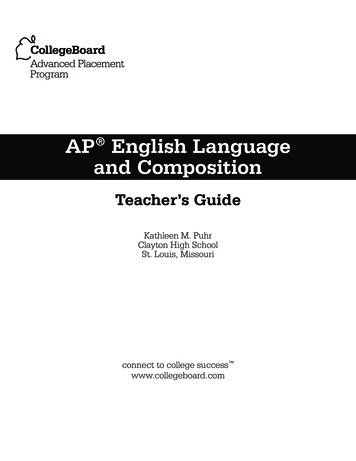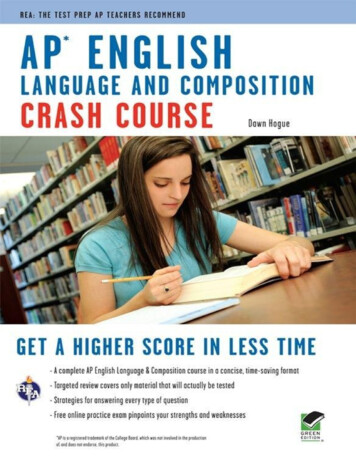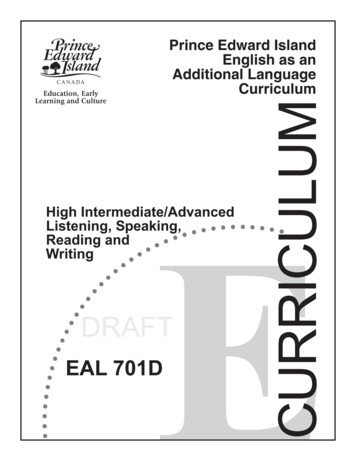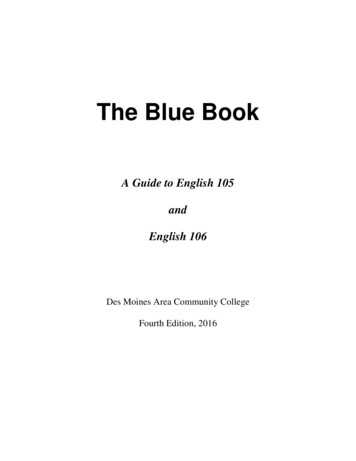
Transcription
AP English Languageand CompositionTeacher’s GuideKathleen M. PuhrClayton High SchoolSt. Louis, Missouriconnect to college success www.collegeboard.com
AP English Language andComposition Teacher’s GuideKathleen M. PuhrClayton High SchoolSt. Louis, Missouri
The College Board: Connecting Students to CollegeSuccessThe College Board is a not-for-profit membership association whose mission is to connect studentsto college success and opportunity. Founded in 1900, the association is composed of more than 5,000schools, colleges, universities, and other educational organizations. Each year, the College Board servesseven million students and their parents, 23,000 high schools, and 3,500 colleges through major programsand services in college admissions, guidance, assessment, financial aid, enrollment, and teaching andlearning. Among its best-known programs are the SAT , the PSAT/NMSQT , and the Advanced PlacementProgram (AP ). The College Board is committed to the principles of excellence and equity, and thatcommitment is embodied in all of its programs, services, activities, and concerns.For further information, visit www.collegeboard.com. 2007 The College Board. All rights reserved. College Board, Advanced Placement Program, AP, APCentral, AP Vertical Teams, Pre-AP, SAT, and the acorn logo are registered trademarks of the CollegeBoard. AP Potential and connect to college success are trademarks owned by the College Board. PSAT/NMSQT is a registered trademark of the College Board and National Merit Scholarship Corporation. Allother products and services may be trademarks of their respective owners. Visit the College Board on theWeb: www.collegeboard.com.ii
ContentsWelcome Letter from the College Board. vEquity and Access.viiParticipating in the AP Course Audit.xiPreface.xiiChapter 1. About AP English Language and Composition. 1Overview: Past, Present, Future. 1Course Description Essentials. 1Key Concepts and Skills. 2College Composition: Goals, Outcomes, Innovations. 4Chapter 2. Advice for AP English Language and Composition Teachers. 11Developing Your Course. 11Encouraging Participation . 12Teaching Tips. 12Working with Parents and Other Teachers. 15Frequently Asked Questions. 17Chapter 3. Course Organization. 20Create Your Own Syllabus. 20Reading . 20Writing . . 21Discussion . 22Four Sample Syllabi. 22Sample Syllabus 1. 25Sample Syllabus 2. 42Sample Syllabus 3. 59Sample Syllabus 4. 79Chapter 4. The AP Exam in English Language and Composition. 103Exam Development. 103Preparing Students. 103After the Exam. 107AP Grade Reports. 108Using the AP Instructional Planning Report . 108iii
ContentsChapter 5. Resources for Teachers. 109How to Address Limited Resources. 109Choosing Resources. 110Professional Development. 121Appendix. 125Judy Griffith’s Scoring Guidelines. 125iv
Welcome Letter from the College BoardDear AP Teacher:Whether you are a new AP teacher, using this AP Teacher’s Guide to assist in developing a syllabus for thefirst AP course you will ever teach, or an experienced AP teacher simply wanting to compare the teachingstrategies you use with those employed by other expert AP teachers, we are confident you will find thisresource valuable. We urge you to make good use of the ideas, advice, classroom strategies, and samplesyllabi contained in this Teacher’s Guide.You deserve tremendous credit for all that you do to fortify students for college success. The nurturingenvironment in which you help your students master a college-level curriculum—a much better atmospherefor one’s first exposure to college-level expectations than the often large classes in which many first-yearcollege courses are taught—seems to translate directly into lasting benefits as students head off to college.An array of research studies, from the classic 1999 U.S. Department of Education study Answers in theTool Box to new research from the University of Texas and the University of California, demonstratethat when students enter high school with equivalent academic abilities and socioeconomic status, thosewho develop the content knowledge to demonstrate college-level mastery of an AP Exam (a grade of 3 orhigher) have much higher rates of college completion and have higher grades in college. The 2005 NationalCenter for Educational Accountability (NCEA) study shows that students who take AP have much highercollege graduation rates than students with the same academic abilities who do not have that valuable APexperience in high school. Furthermore, a Trends in International Mathematics and Science Study (TIMSS,formerly known as the Third International Mathematics and Science Study) found that even AP Calculusstudents who score a 1 on the AP Exam are significantly outperforming other advanced mathematicsstudents in the United States, and they compare favorably to students from the top-performing nations inan international assessment of mathematics achievement. (Visit AP Central at apcentral.collegeboard.comfor details about these and other AP-related studies.)For these reasons, the AP teacher plays a significant role in a student’s academic journey. Your APclassroom may be the only taste of college rigor your students will have before they enter higher education.It is important to note that such benefits cannot be demonstrated among AP courses that are AP courses inname only, rather than in quality of content. For AP courses to meaningfully prepare students for collegesuccess, courses must meet standards that enable students to replicate the content of the comparable collegeclass. Using this AP Teacher’s Guide is one of the keys to ensuring that your AP course is as good as (oreven better than) the course the student would otherwise be taking in college. While the AP Programdoes not mandate the use of any one syllabus or textbook and emphasizes that AP teachers should begranted the creativity and flexibility to develop their own curriculum, it is beneficial for AP teachers tocompare their syllabi not just to the course outline in the official AP Course Description and in chapter 3of this guide, but also to the syllabi presented on AP Central, to ensure that each course labeled AP meetsthe standards of a college-level course. Visit AP Central at apcentral.collegeboard.com for details aboutthe AP Course Audit, course-specific Curricular Requirements, and how to submit your syllabus for APCourse Audit authorization.As the Advanced Placement Program continues to experience tremendous growth in the twenty-firstcentury, it is heartening to see that in every U.S. state and the District of Columbia, a growing proportionof high school graduates have earned at least one grade of 3 or higher on an AP Exam. In some states, more
Welcome Letterthan 20 percent of graduating seniors have accomplished this goal. The incredible efforts of AP teachersare paying off, producing ever greater numbers of college-bound seniors who are prepared to succeed incollege. Please accept my admiration and congratulations for all that you are doing and achieving.Sincerely,Marcia WilburDirector, Curriculum and Content DevelopmentAdvanced Placement Programvi
Equity and AccessIn the following section, the College Board describes its commitment to achieving equity in the APProgram.Why are equitable preparation and inclusion important?Currently, 40 percent of students entering four-year colleges and universities and 63 percent of students attwo-year institutions require some remedial education. This is a significant concern because a student isless likely to obtain a bachelor’s degree if he or she has taken one or more remedial courses.1Nationwide, secondary school educators are increasingly committed not just to helping studentscomplete high school but also to helping them develop the habits of mind necessary for managing therigors of college. As Educational Leadership reported in 2004:The dramatic changes taking place in the U.S. economy jeopardize the economic future of studentswho leave high school without the problem-solving and communication skills essential to successin postsecondary education and in the growing number of high-paying jobs in the economy. Toback away from education reforms that help all students master these skills is to give up on thecommitment to equal opportunity for all.2Numerous research studies have shown that engaging a student in a rigorous high school curriculum suchas is found in AP courses is one of the best ways that educators can help that student persist and completea bachelor’s degree.3 However, while 57 percent of the class of 2004 in U.S. public high schools enrolled inhigher education in fall 2004, only 13 percent had been boosted with a successful AP experience in highschool.4 Although AP courses are not the only examples of rigorous curricula, there is still a significantgap between students with college aspirations and students with adequate high school preparation to fulfillthose aspirations.Strong correlations exist between AP success and college success.5 Educators attest that this is partlybecause AP enables students to receive a taste of college while still in an environment that provides moresupport and resources for students than do typical college courses. Effective AP teachers work closelywith their students, giving them the opportunity to reason, analyze, and understand for themselves. As aresult, AP students frequently find themselves developing new confidence in their academic abilities anddiscovering their previously unknown capacities for college studies and academic success.1. Andrea Venezia, Michael W. Kirst, and Anthony L. Antonio, Betraying the College Dream: How Disconnected K–12 and PostsecondaryEducation Systems Undermine Student Aspirations (Palo Alto, Calif.: The Bridge Project, 2003), 8.2. Frank Levy and Richard J. Murnane, “Education and the Changing Job Market.” Educational Leadership 62 (2) (October 2004): 83.3. In addition to studies from University of California–Berkeley and the National Center for Educational Accountability (2005), see theclassic study on the subject of rigor and college persistence: Clifford Adelman, Answers in the Tool Box: Academic Intensity, AttendancePatterns, and Bachelor’s Degree Attainment (Washington, D.C.: U.S. Department of Education, 1999).4. Advanced Placement Report to the Nation (New York: College Board, 2005).5. Wayne Camara, “College Persistence, Graduation, and Remediation,” College Board Research Notes (RN-19) (New York: College Board,2003).vii
Equity and AccessWhich students should be encouraged to registerfor AP courses?Any student willing and ready to do the work should be considered for an AP course. The College Boardactively endorses the principles set forth in the following Equity Policy Statement and encourages schoolsto support this policy.The College Board and the Advanced Placement Program encourage teachers, AP Coordinators,and school administrators to make equitable access a guiding principle for their AP programs. TheCollege Board is committed to the principle that all students deserve an opportunity to participate inrigorous and academically challenging courses and programs. All students who are willing to acceptthe challenge of a rigorous academic curriculum should be considered for admission to AP courses.The Board encourages the elimination of barriers that restrict access to AP courses for students fromethnic, racial, and socioeconomic groups that have been traditionally underrepresented in the APProgram. Schools should make every effort to ensure that their AP classes reflect the diversity of theirstudent population.The fundamental objective that schools should strive to accomplish is to create a stimulating APprogram that academically challenges students and has the same ethnic, gender, and socioeconomicdemographics as the overall student population in the school. African American and Native Americanstudents are severely underrepresented in AP classrooms nationwide; Latino student participation hasincreased tremendously, but in many AP courses Latino students remain underrepresented. To prevent awilling, motivated student from having the opportunity to engage in AP courses is to deny that student thepossibility of a better future.Knowing what we know about the impact a rigorous curriculum can have on a student’s future, it isnot enough for us simply to leave it to motivated students to seek out these courses. Instead, we must reachout to students and encourage them to take on this challenge. With this in mind, there are two factors toconsider when counseling a student regarding an AP opportunity:1. Student motivationMany potentially successful AP students would never enroll if the decision were left to their own initiative.They may not have peers who value rigorous academics, or they may have had prior academic experiencesthat damaged their confidence or belief in their college potential. They may simply lack an understandingof the benefits that such courses can offer them. Accordingly, it is essential that we not gauge a student’smotivation to take AP until that student has had the opportunity to understand the advantages—not justthe challenges—of such course work.Educators committed to equity provide all students in a school with an understanding of the benefits ofrigorous curricula. Such educators conduct student assemblies and/or presentations to parents that clearlydescribe the advantages of taking an AP course and outline the work expected of students. Perhaps mostimportant, they have one-on-one conversations with the students in which advantages and expectations areplaced side by side. These educators realize that many students, lacking confidence in their abilities, willbe listening for any indication that they should not take an AP course. Accordingly, such educators, whilefrankly describing the amount of homework to be anticipated, also offer words of encouragement andsupport, assuring the students that if they are willing to do the work, they are wanted in the course.The College Board has created a free online tool, AP Potential , to help educators reach out tostudents who previously might not have been considered for participation in an AP course. Drawing upondata based on correlations between student performance on specific sections of the PSAT/NMSQT andviii
Equity and Accessperformance on specific AP Exams, AP Potential generates rosters of students at your school who havea strong likelihood of success in a particular AP course. Schools nationwide have successfully enrolledmany more students in AP than ever before by using these rosters to help students (and their parents)see themselves as having potential to succeed in college-level studies. For more information, visit http://appotential.collegeboard.com.Actively recruiting students for AP and sustaining enrollment can also be enhanced by offeringincentives for both students and teachers. While the College Board does not formally endorse any oneincentive for boosting AP participation, we encourage school administrators to develop policies that willbest serve an overarching goal to expand participation and improve performance in AP courses. Whensuch incentives are implemented, educators should ensure that quality verification measures such as the APExam are embedded in the program so that courses are rigorous enough to merit the added benefits.Many schools offer the following incentives for students who enroll in AP: Extra weighting of AP course grades when determining class rankFull or partial payment of AP Exam feesOn-site exam administrationAdditionally, some schools offer the following incentives for teachers to reward them for their efforts toinclude and support traditionally underserved students: Extra preparation periodsReduced class sizeReduced duty periodsAdditional classroom fundsExtra salary2. Student preparationBecause AP courses should be the equivalent of courses taught in colleges and universities, it is importantthat a student be prepared for such rigor. The types of preparation a student should have before enteringan AP course vary from course to course and are described in the official AP Course Description book foreach subject (available as a free download at apcentral.collegeboard.com).Unfortunately, many schools have developed a set of gatekeeping or screening requirements that go farbeyond what is appropriate to ensure that an individual student has had sufficient preparation to succeedin an AP course. Schools should make every effort to eliminate the gatekeeping process for AP enrollment.Because research has not been able to establish meaningful correlations between gatekeeping devices andactual success on an AP Exam, the College Board strongly discourages the use of the following factors asthresholds or requirements for admission to an AP course: Grade point averageGrade in a required prerequisite courseRecommendation from a teacherix
Equity and Access AP teacher’s discretionStandardized test scoresCourse-specific entrance exam or essayAdditionally, schools should be wary of the following concerns regarding the misuse of AP: Creating “Pre-AP courses” to establish a limited, exclusive track for access to APRushing to install AP courses without simultaneously implementing a plan to prepare students andteachers in lower grades for the rigor of the programHow can I ensure that I am not watering down the qualityof my course as I admit more students?Students in AP courses should take the AP Exam, which provides an external verification of the extentto which college-level mastery of an AP course is taking place. While it is likely that the percentageof students who receive a grade of 3 or higher may dip as more students take the exam, that is not anindication that the quality of a course is being watered down. Instead of looking at percentages, educatorsshould be looking at raw numbers, since each number represents an individual student. If the raw numberof students receiving a grade of 3 or higher on the AP Exam is not decreasing as more students take theexam, there is no indication that the quality of learning in your course has decreased as more students haveenrolled.What are schools doing to expand access and improveAP performance?Districts and schools that successfully improve both participation and performance in AP haveimplemented a multipronged approach to expanding an AP program. These schools offer AP as capstonecourses, providing professional development for AP teachers and additional incentives and support forthe teachers and students participating at this top level of the curriculum. The high standards of the APcourses are used as anchors that influence the 6–12 curriculum from the “top down.” Simultaneously,these educators are investing in the training of teachers in the pre-AP years and are building a verticallyarticulated, sequential curriculum from middle school to high school that culminates in AP courses—abroad pipeline that prepares students step-by-step for the rigors of AP so that they will have a fair shot atsuccess in an AP course once they reach that stage. An effective and demanding AP program necessitatescooperation and communication between high schools and middle schools. Effective teaming amongmembers of all educational levels ensures rigorous standards for students across years and provides themwith the skills needed to succeed in AP. For more information about Pre-AP professional development,including workshops designed to facilitate the creation of AP Vertical Teams of middle school and highschool teachers, visit AP Central.Advanced Placement ProgramThe College Board
Participating in the AP Course AuditOverviewThe AP Course Audit is a collaborative effort among secondary schools, colleges and universities, and theCollege Board. For their part, schools deliver college-level instruction to students and complete and returnAP Course Audit materials. Colleges and universities work with the College Board to define elementscommon to college courses in each AP subject, help develop materials to support AP teaching, and receivea roster of schools and their authorized AP courses. The College Board fosters dialogue about the APCourse Audit requirements and recommendations and reviews syllabi.Starting in the 2007-08 academic year, all schools wishing to label a course “AP” on student transcripts,course listings, or any school publications must complete and return the subject-specific AP Course Auditform, along with the course syllabus, for all sections of their AP courses. Approximately two months aftersubmitting AP Course Audit materials, schools will receive a legal agreement authorizing the use of the“AP” trademark on qualifying courses. Colleges and universities will receive a roster of schools listing thecourses authorized to use the “AP” trademark at each school.PurposeCollege Board member schools at both the secondary and college levels requested an annual AP CourseAudit in order to provide teachers and administrators with clear guidelines on curricular and resourcerequirements that must be in place for AP courses and to help colleges and universities better interpretsecondary school courses marked “AP” on students’ transcripts.The AP Course Audit form identifies common, essential elements of effective college courses, includingsubject matter and classroom resources such as college-level textbooks and laboratory equipment. Schoolsand individual teachers will continue to develop their own curricula for AP courses they offer—the APCourse Audit will simply ask them to indicate inclusion of these elements in their AP syllabi or describehow their courses nonetheless deliver college-level course content.AP Exam performance is not factored into the AP Course Audit. A program that audited only thoseschools with seemingly unsatisfactory exam performance might cause some schools to limit access toAP courses and exams. In addition, because AP Exams are taken and exam grades reported after collegeadmissions decisions are already made, AP course participation has become a relevant factor in the collegeadmissions process. On the AP Course Audit form, teachers and administrators attest that their courseincludes elements commonly taught in effective college courses. Colleges and universities reviewingstudents’ transcripts can thus be reasonably assured that courses labeled “AP” provide an appropriate leveland range of college-level course content, along with the classroom resources to best deliver that content.For more informationYou should discuss the AP Course Audit with your department head and principal. For more information,including a timeline, frequently asked questions, and downloadable AP Course Audit forms, visitapcentral.collegeboard.com/courseaudit.xi
PrefaceTo those of you who will be teaching an AP English Language and Composition course for the first time,welcome to the community of AP English Language and Composition teachers. No doubt you will havequestions as you begin your journey into this new landscape. This Teacher’s Guide is meant to anticipatesome of those questions, to provide a partial road map, and to assure you that a network of AP EnglishLanguage teachers is out there ready and willing to share texts and techniques.Because both the AP English Language and Composition and English Literature and CompositionExams are skills-based as opposed to content-based, teachers have tremendous latitude in designingtheir classes. That latitude can be daunting. The course prescribes no core curriculum, no list of requiredtitles, and no particular chapters to cover. Specific skills, however, are central to the course. Thus, thisguide highlights those skills through the description of the course, as well as through a college teacher’spresentation of the rudiments of rhetoric (the heart of AP English Language and Composition), a sectioncontaining sample syllabi, a description of the exam itself, and a section about resources. In addition,veteran AP English Language and Composition teachers offer their perspectives on course design andexam preparation, as well as suggestions for establishing an AP program at schools with limited resources.Teachers also share lesson plans that have proven successful.This guide is only a starting point. It will lead you toward some strategies and designs that might besuitable for your students, but it is by no means the last word or the definitive plan for teaching the course.You are encouraged to develop your own ideas and to discover your own path. The contributing teachersare accessible and can help you, as can your College Board regional office. With time and experience, youwill be able to create a guide of your own, and you can pass this one along (in its present or revised form)to a novice AP teacher.To you veteran AP teachers, whether of 1 year or 31, this guide will offer some updates. Included arestatements from the Council of Writing Program Administrators, an organization that helps providedirection for college composition courses. The philosophy and objectives currently governing the teachingof writing at the college level should prove particularly helpful to you as you reflect on your course. Theguide also includes four new syllabi, all of which emphasize the teaching of nonfiction and the importanceof rhetorical analysis, argument, and research skills.The abilities to synthesize and to analyze and construct arguments are increasingly important in thecollege composition community and therefore should be central to your course. Through the sample syllabiand some of the advice boxes, you will see how students are working with multiple texts—including visualones—on related subjects. There are also examples of the types of argument that students can practice.Chapter 5 contains lists of resources and a reminder that AP Central (the College Board Web site) offershundreds of reviews of textbooks and other teaching aids for the course. Although it can be said that thereis nothing new under the sun, resources continue to proliferate, and chapter 5 addresses that reality.xii
PrefaceWith gratitude for their expertise and encouragement, I acknowledge my editors: Jamieson Spencer,St. Louis teacher and friend, and Pam Cruise and Karen Nulton, my friendly ETS teachers. Thanks as wellto my students, for teaching me; to my husband, Louis Axeman, for his unfailing support, and to my cats—Grace, Joy, and Hope—who throughout this project have perched on my lap and atop my comp
AP English Language and Composition Teacher’s Guide Kathleen M. Puhr Clayton High School St. Louis, Missouri. ii The College Board: Connecting Students to College Success The College Board is a not-for-profit membership association whose mission is to connect students










